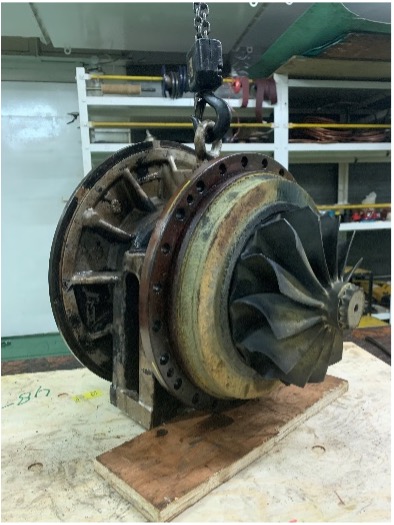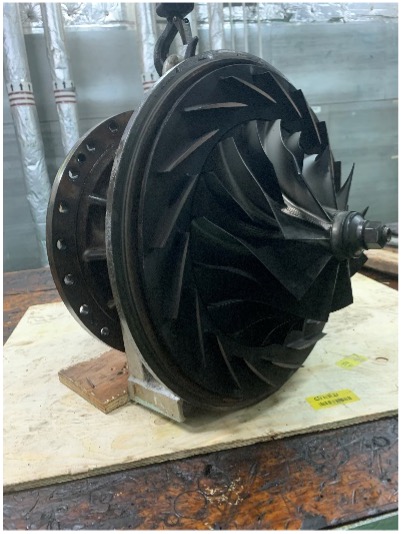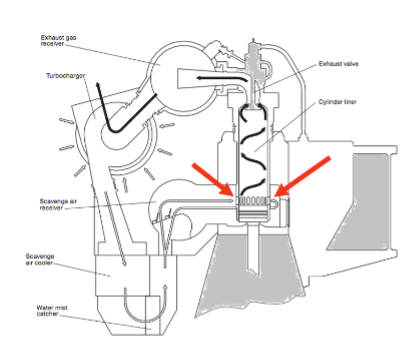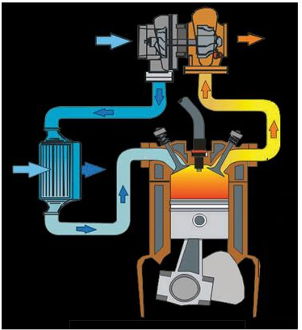By supplying enough amount of fresh air inside the cylinder for the next cycle, proper combustion of fuel/air ratio can take place during the compression stage, this method is what they call scavenging in marine engines.
Scavenging air is supplied by the engine’s exhaust gas-driven turbocharger, but for some instances especially during maneuvering, is able to maintain the scavenging pressure/charged air pressure, an auxiliary blower is installed to provide extra pressure to provide enough charged air needed for the marine fuel to burn efficiently.
Aside from filling the cylinder with a new fuel/air mixture for the next cycle, the scavenging method also simultaneously purges exhaust gas along with some unburnt fuel and carbon going to the exhaust manifold.
However, if scavenging is incomplete or less air is charged, improper combustion might occur, which will reduce the power output of the engine. Concerning this, less charged air might happen if the turbocharger is not working properly probably because the turbines are dirty, stuck, or have some wear.
That’s why it is essential to have a routine for cleaning the turbocharger with water or marine grits and follow a pre-maintenance schedule especially when the running hours are already reached.
Why scavenging is required?
Scavenging is required to provide adequate air for the fuel/air mixture that is to be burned inside the cylinder and increases the capability of the engine. Also, they tend to clean the combustion chamber by supplying charged air and simultaneously pushing the exhaust gas along with the carbon, unburnt fuel, and some combustion residue.
What is scavenging efficiency?
Scavenge efficiency is the ratio of the mass of air being charged in the cylinder at the beginning of the compression and the mass of air used by the compression at the end of the combustion. Also, scavenge efficiency depends on the temperature of the air. The cooler the air, the denser it becomes hence more mass and more scavenging efficiency.
Lastly, scavenging is very important for the efficient combustion of fuel/air mixture, so just remember that to provide enough charged air, the turbocharger, as well as the auxiliary blower, must be taken care of properly.
Follow maintenance plans according to their running hours and change the air filters of the compressor side of the turbocharger frequently. In this manner, not only you can maximize the ship’s capabilities but also helps shrug off unburnt fuel and combustion residues inside the cylinder.
What are the parts of the engines that play a role in providing charge air?
Several parts of the engine is considered responsible for providing enough scavenging/charged air pressure. Each one of them plays a vital role in a whole scavenging system, without the other, scavenging pressure can’t be achieved which will lead to poor combustion of fuel.
Turbocharger
A turbocharger is composed of two parts, the compressor side, and the turbine side. Furthermore, both parts are connected by a shaft.
The exhaust of the engine is utilized bypassing the turbine side, making the turbocharger rotate. As the turbine side rotates, the compressor also rotates thus taking in air and compressing it to be used as scavenging air for combustion. When the air suctioned in is compressed and squeezes into the engine’s cylinder, it allows high pressure and quantity of air to enter the engine.
Since the turbocharger is dependent on the exhaust gas of the engine to run, what about during starting? Or when there is only less rpm/speed and less combustion? How can it produce enough charged air pressure for the cycle? For this matter, the manufacturers installed auxiliary blowers to help provide charged air pressure.
Example of the turbocharger of a 4-stroke diesel generator engine:


Auxiliary blower
Auxiliary blowers are provided to assist the turbocharger in providing enough charged air/scavenging pressure. Mostly, they start at 0.35 bars and stop at 0.45 bars where the turbochargers can maintain the pressure by themselves. Backflow to the air receiver is where the air is blown in and is prevented by air flaps. Without it, there would be improper combustion inside the cylinder during start-up or during maneuvering on less rpm.
Air-cooler
Air coolers are fitted between the turbocharger and the scavenge manifold. They help to reduce the temperature of the charged air before it is introduced to the engine, thus increasing the efficiency of the engine. Air coolers use fresh water as a coolant, and it is important to monitor the pressure of the cooling air pressure to avoid thermal damage to the pipes and tubes inside the air cooler.
Scavenging manifold
After the charged air is cooled, it goes directly to the air receiver and for some type of engine like the generator engines, to the scavenging manifold. This is where the scavenged air is stored before it will be used for combustion.
Example of scavenging manifold of a 2-stroke diesel main engine:

*Cleaning of this manifold should be planned, for this will need the main engine to be stopped for a few hours in order for this to be opened and cleaned.
Exhaust manifold
Exhaust manifolds serve as the area where the exhaust gasses generated from the cylinder after burning are stored for the meantime. As the exhaust is collected to the exhaust manifold, it then can give sufficient power and pressure to drive the turbine side of the turbocharger as it passes there before it is discharged to the atmosphere.
Simplified drawing of the scavenging system


What are the three types of scavenging?
Even though there are different types of scavenging, the basic theory/principle is still the same – the charge air enters the opening during the downstroke of the piston and then stops supplying on closing during the upward stroke. The only difference between them is the locations of the scavenging ports and the exhaust arrangements.
Cross-flow Scavenging
The inlet and exhaust ports are located on opposite sides, that is why it is called cross-flow type. Furthermore, the exhaust port is located at a higher level than the inlet port. During the combustion, as the piston goes downward because of the expansion of the gas, it first uncovers the port located at the higher level, which is the exhaust port.
Since is exhaust port is uncovered first, the exhaust gasses are released because the pressure of the exhaust gas is higher than the atmospheric pressure. As the piston moves further down, it opens the inlet port to let the newly charged air enter the cylinder for the next cycle.
Loop Scavenging
Loop scavenging is almost the same as the cross-flow, the only difference they have is that on loop scavenging, the exhaust and inlet ports are located on the same side. The exhaust ports are still located higher than the inlet port and will be opened first as the piston moves downward.
When the inlet port is opened, the charged air is introduced for the new fuel/air cycle and rises towards the cylinder head, it then pushes the exhaust gas out of the cylinder.
Advantages and Disadvantages of Loop and Cross-flow Scavenging
These types have the benefit of not needing an exhaust valve, leading to simpler designs. Additionally, they prevent thermal stress on the cylinders caused by the installation of exhaust valves.
Regrettably, modern engines no longer include these types. The reason for their discontinuation is that they were unable to effectively remove carbon debris from the cylinder during scavenging. Additionally, the limited scavenging time resulted in the accumulation of carbon and combustion residue, eventually leading to blockage of the exhaust port over time.
Uniflow Scavenging
Uniflow Scavenging is fitted with an exhaust valve mounted at the top of the cylinder– thus it is not dependent on the movement of the piston, unlike the two types of scavenging. Charged air is introduced at the lower end of the cylinder liner when the piston opens the inlet port, then exits at the exhaust valve as exhaust gas after combustion. The cycle repeats always, charged air in at the bottom then leaves at the top.
Advantages
The main advantage of Uniflow Scavenging is the longest time of opening and closing of valves, which helps remove combustion residues on time. Moreover, the timing of exhaust valves can be altered also with the help of “Variable Exhaust Timing” to suit the requirements of varying load and engine speeds.
- Types of Gas Carriers as per IGC Code – April 22, 2025
- Wind-Assisted Propulsion Systems (WAPS): A Game Changer for Maritime Decarbonization – February 6, 2025
- 10 Boat Salvage Yards in California – January 25, 2025



